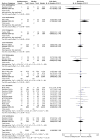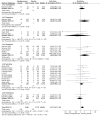Effects of Antidepressants on Sleep in Post-traumatic Stress Disorder: An Overview of Reviews
- PMID: 37533247
- PMCID: PMC10845105
- DOI: 10.2174/1570159X21666230801144328
Effects of Antidepressants on Sleep in Post-traumatic Stress Disorder: An Overview of Reviews
Abstract
Antidepressants are a commonly used, easily accessible, and overall safe treatment option for post-traumatic stress disorder (PTSD). The present review aims to evaluate the efficacy and safety of antidepressants in treating sleep disturbances in patients with PTSD. PubMed and the Cochrane Library were searched (July 2022) for systematic reviews and meta-analyses on the treatment of PTSD. Moreover, PubMed and ClinicalTrials.gov were searched for individual trials investigating the antidepressant treatment of PTSD (up to September 2022), and reference lists of all possibly relevant identified studies were screened. Sleep-related outcomes, i.e., total sleep time, sleep quality, dreams/ nightmares, insomnia, and somnolence, were extracted independently by at least two reviewers. Metaanalytic evaluations were performed wherever possible. 39 randomised controlled trials (RCTs) were identified; data from pooled analyses, reviews, and observational studies were used for antidepressants with a weak evidence base or when their findings were deemed important. Overall, scarce data exist on the effects of antidepressants on sleep outcomes among patients with PTSD. Some evidence may support the use of amitriptyline, nefazodone, paroxetine, and sertraline for improving sleep in patients with PTSD. Τhere was a meta-analytical trend indicating improvement of nightmares with fluoxetine, less insomnia with amitriptyline and more with brofaromine, as well as more somnolence with paroxetine vs. placebo, respectively. However, data from more than 1 RCT with a considerable number of patients were only available for paroxetine. Evidence is insufficient to draw safe conclusions. More and better-designed RCTs, with consistent reporting of sleep-related outcomes, are needed.
Keywords: PTSD; Post-traumatic stress disorder; dreams; insomnia; meta-analysis.; nightmares; sleep; somnolence.
Copyright© Bentham Science Publishers; For any queries, please email at epub@benthamscience.net.
Conflict of interest statement
The authors declare no conflict of interest, financial or otherwise.
Figures








Similar articles
-
Pharmacotherapy for sleep disturbances in post-traumatic stress disorder (PTSD): A network meta-analysis.Sleep Med. 2024 Jul;119:467-479. doi: 10.1016/j.sleep.2024.05.032. Epub 2024 May 20. Sleep Med. 2024. PMID: 38795401 Review.
-
Pharmacotherapeutic treatment of nightmares and insomnia in posttraumatic stress disorder: an overview of the literature.Ann N Y Acad Sci. 2006 Jul;1071:502-7. doi: 10.1196/annals.1364.053. Ann N Y Acad Sci. 2006. PMID: 16891608 Review.
-
Factors impacting prazosin efficacy for nightmares and insomnia in PTSD patients - a systematic review and meta-regression analysis.Prog Neuropsychopharmacol Biol Psychiatry. 2025 Jan 10;136:111253. doi: 10.1016/j.pnpbp.2025.111253. Epub 2025 Jan 17. Prog Neuropsychopharmacol Biol Psychiatry. 2025. PMID: 39828080
-
Sleep disturbances in patients with post-traumatic stress disorder: epidemiology, impact and approaches to management.CNS Drugs. 2006;20(7):567-90. doi: 10.2165/00023210-200620070-00003. CNS Drugs. 2006. PMID: 16800716 Review.
-
Sleep in posttraumatic stress disorder.Ann Clin Psychiatry. 2002 Sep;14(3):183-90. doi: 10.1023/a:1021190620773. Ann Clin Psychiatry. 2002. PMID: 12585568 Review.
Cited by
-
Sleep Deprivation and Alzheimer's Disease: A Review of the Bidirectional Interactions and Therapeutic Potential of Omega-3.Brain Sci. 2025 Jun 14;15(6):641. doi: 10.3390/brainsci15060641. Brain Sci. 2025. PMID: 40563811 Free PMC article. Review.
-
Thematic Selection: Stress and Stress-related Disorders Posttraumatic Stress Disorder (Part 2).Curr Neuropharmacol. 2024;22(4):522-523. doi: 10.2174/1570159X2204231106143917. Curr Neuropharmacol. 2024. PMID: 38284340 Free PMC article. No abstract available.
References
-
- Goldstein R.B., Smith S.M., Chou S.P., Saha T.D., Jung J., Zhang H., Pickering R.P., Ruan W.J., Huang B., Grant B.F. The epidemiology of DSM-5 posttraumatic stress disorder in the United States: Results from the National Epidemiologic Survey on Alcohol and Related Conditions-III. Soc. Psychiatry Psychiatr. Epidemiol. 2016;51(8):1137–1148. doi: 10.1007/s00127-016-1208-5. - DOI - PMC - PubMed
-
- Murthy R.S. Conflict situations and mental health care in developing countries. In: Christodoulou G.N., Mezzich J.E., Christodoulou N.G., Lecic-Tosevski D., editors. Disasters: mental health context and responses 1st ed. Cambridge Scholars Publishing: Newcastle upon Tyne, England; 2016. pp. 151–172.
Publication types
MeSH terms
Substances
LinkOut - more resources
Full Text Sources
Medical

